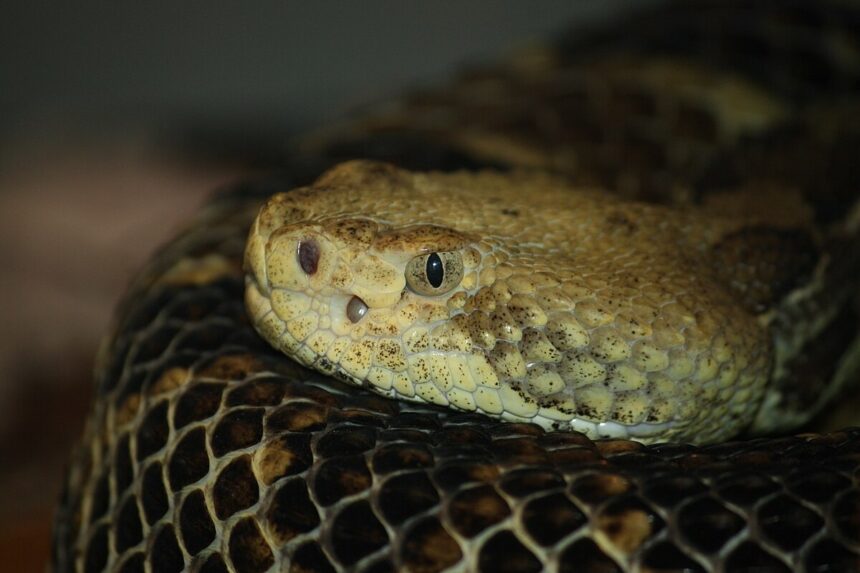When you step outside into your backyard, what do you envision? Lush greenery, the chirping of birds, perhaps even a playful pet frolicking in the grass. But lurking beneath the surface of this idyllic scene could be a silent inhabitant—the pit viper. These fascinating yet often misunderstood snakes are more than just an intriguing part of our ecosystem; they can pose hidden dangers if you’re not aware. As we dive deeper into the world of pit vipers, you’ll discover their unique traits and behaviors, as well as essential tips for safely sharing your outdoor space with these remarkable reptiles. Whether you’re a nature enthusiast or simply enjoy spending time outdoors, understanding pit vipers is crucial for ensuring both your safety and theirs.
Common Species of Pit Vipers in the U.
S
Pit vipers are a diverse group of snakes found throughout the United States. Among them, the Eastern Diamondback Rattlesnake is one of the most well-known. With its striking diamond patterns and formidable size, it commands respect in its habitats across the southeastern U.
S.
The Western Diamondback Rattlesnake is another prominent species. Recognizable by its loud rattle and distinctive markings, it thrives in arid regions from Texas to Arizona.
The Copperhead stands out with its unique coloration—a blend of browns and oranges that allows it to blend seamlessly into leaf litter. Despite their fearsome reputation, they are often shy and will avoid confrontation when possible.
There’s the Cottonmouth or Water Moccasin. This semi-aquatic snake displays bold defensive behaviors when threatened but plays a vital role in controlling fish populations in wetland ecosystems. Each species contributes uniquely to our natural environment while reminding us of their silent presence nearby.
Habitat and Behavior of Pit Vipers
Pit vipers thrive in a range of habitats, from dense forests to rocky hillsides. They are often found in areas with ample cover, as these environments provide both shelter and hunting grounds.
These snakes are primarily nocturnal hunters. At night, they venture out to seek their prey, which mostly consists of small mammals and birds. Their keen sense of heat detection allows them to locate warm-blooded animals even in complete darkness.
During the day, pit vipers can be elusive. They may bask on rocks or hide among leaves and debris. In cooler weather, they may share dens with other snake species for warmth.
Social interactions are minimal outside mating season. Males will engage in combat rituals to establish dominance when vying for a female’s attention. This behavior is fascinating yet rarely witnessed by humans due to its discreet nature.
Dangers and Risks of Pit Viper Bites
Pit viper bites pose serious health risks. Their venom is potent and can lead to severe symptoms, ranging from intense pain to swelling.
The toxins in their bite can damage tissues. This may result in necrosis, requiring medical intervention or even surgery in extreme cases.
Additionally, pit viper bites often induce systemic reactions. These include nausea, dizziness, and difficulty breathing. An allergic reaction can exacerbate these symptoms.
Prompt treatment is crucial for anyone bitten by a pit viper. Delays can increase the severity of complications and prolong recovery times.
Awareness of the dangers associated with these snakes helps promote safety. Understanding how they behave also plays a key role in preventing encounters that could lead to bites.
Tips for Avoiding Encounters with Pit Vipers
To minimize encounters with pit vipers, awareness is crucial. Always stay vigilant when exploring areas known for snake activity.
Wearing boots and long pants can provide added protection. Sturdy footwear shields your legs from accidental bites while hiking or walking in tall grass.
Make noise as you move through potential habitats. Snakes are often startled by sound, prompting them to retreat before you get too close.
Avoiding dusk and dawn outings is wise, as these snakes are most active during those times. Opt for midday hikes when the sun is high.
Keeping yards tidy also helps deter pit vipers. Clear away debris, woodpiles, and overgrown vegetation where they might hide.
Educating others about snake behavior fosters a safer community environment. Understanding how to respect their space can significantly reduce unwanted encounters in shared outdoor spaces.
What to Do If You Are Bitten by a Pit Viper
If you are bitten by a pit viper, stay calm. Panic can elevate your heart rate and spread venom more quickly.
Call for emergency help immediately. It’s crucial to get medical attention as soon as possible. Time is of the essence when dealing with snake bites.
Keep the affected limb immobilized and at or below heart level. This helps slow down the movement of venom through your body.
Do not try to suck out the venom or apply ice. These methods can worsen your condition instead of helping it.
Remove any tight clothing or jewelry near the bite site, as swelling may occur. Be cautious about how you move; avoid unnecessary activity that could increase blood flow to the area.
Remember every detail about the snake if possible—its color, size, and pattern—as this information will assist medical professionals in treating you effectively.
Conservation Efforts for Pit Vipers
Conservation efforts for pit vipers are crucial in maintaining ecological balance. These snakes play a significant role in controlling rodent populations, which can impact agriculture and human health.
Various organizations focus on habitat preservation, ensuring that these reptiles have safe environments to thrive. Educational programs raise awareness about the importance of pit vipers and debunk myths that contribute to their negative image.
Research initiatives also seek to understand their behavior and ecology better. By studying pit viper movements and interactions with other wildlife, scientists can develop effective conservation strategies.
Community involvement is vital too. Local groups often organize clean-up events or create protected areas where these snakes can live undisturbed. Engaging the public fosters a sense of responsibility toward preserving natural habitats.
Collaborations between government agencies and non-profit organizations amplify these efforts, pooling resources for greater impact in protecting pit viper populations across various regions.
Conclusion: The Importance of Coexisting with Wildlife
Coexisting with wildlife is essential for maintaining the balance of our ecosystems. Pit vipers, though often misunderstood and feared, play a crucial role in controlling rodent populations and supporting biodiversity. By respecting their habitat and understanding their behavior, we can minimize conflicts.
Educating ourselves about these snakes fosters appreciation rather than fear. When we learn to identify common species like the copperhead or cottonmouth, we become more aware of our surroundings. This knowledge allows us to enjoy nature while remaining safe.
Encouraging conservation efforts helps protect pit vipers and their habitats from destruction. Supporting local organizations that promote awareness can lead to healthier ecosystems where humans and wildlife thrive side by side.
Embracing this coexistence enriches our lives and ensures future generations will witness the beauty of all creatures, including those silent but essential pit vipers lurking in the grass.


